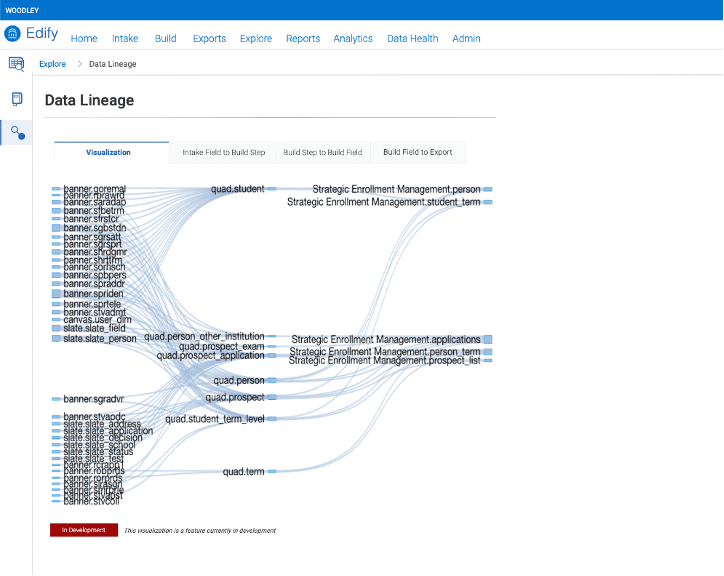3 reasons to invest in higher ed data governance
Data leaders often tell us they need better data governance. But as we speak with each one, it’s clear that they all have different concepts of what data governance is. And many lack a clear understanding of how data and technology tools can support their data governance goals.
The following reflections on effective data governance and its importance come from a series of interviews with EAB staff and our Edify partners including provosts, chiefs of staff, chief information officers (CIO), and more. In addition to our interviews, at the start of our partnerships we ask various stakeholders—ranging from cabinet members to analysts—how they think their institutions measures up in terms of governance practices. Here’s what I learned from those surveys and conversations.
What is higher ed “data governance”?
Data governance is both a process and a policy. Our partners unanimously agreed that successful data governance takes time, work, and organizational support. It requires input from numerous stakeholders, from the highest levels of leadership down through the newest analyst, and it also requires structure and organization. Data governance can’t simply be bought or acquired (though technology and external support facilitate the process).
The overarching takeaway from our interviews was that successful data governance lays the foundation to make data useable, trustworthy, and accessible by the institution. Below, we will dive a bit deeper into each of these three elements and explore how technology can support efforts in each domain.
Leadership Perspectives on Higher Education Data Strategy
3 goals of higher ed data governance
1. Make data useable
Nearly every partner we spoke to through our interviews cited creating a “single source of truth” as a core component of data governance. But it’s clear this is much easier said than done: partners mentioned difficulty “getting the beans to add up”–different departments or staff members reach different conclusions depending on what data they’re looking at. When report writers or consumers are allowed to use different datasets to derive different answers to the same question, it causes confusion and distrust.
Additionally, two thirds of interviewees said they need everyone on campus to understand and agree with a common set of definitions. In other words, they need transparent definitions in something like a data dictionary or glossary. A data dictionary helps data consumers better understand the data they’re presented.
What technology tools help you make data useable?
- Data Dictionaries compile metadata to help technical users define and understand their data. This typically includes items such as data type, file size, last refresh, and others.
- Data Glossaries (also known as Business Glossaries) define functional business terms. They can be used by both technical and non-technical teams. Glossary entries can range from terms like “Faculty Headcount” or “Active Students” to more complex terms like “Annual Department Review Process.”
- Documentation Hubs help consumers understand the various processes related to their data. There are many technologies that can serve as documentation hubs, and they all serve the same purpose: creating a central source related to institutional policies and procedures.
Despite the overwhelming need for data dictionaries, they’re hard to implement: EAB’s data strategy audits found that data leaders and users overwhelmingly rate their institutions’ implementation of a common data dictionary poorly. (Across 653 data leaders and users surveyed, the aggregate score for data dictionary implementation was just 1.2 on a scale of zero to four (0 = not at all, 1= poorly, 2= somewhat, 3= fairly well, 4=very well)).
2. Make data trustworthy
Trust in data starts at the top. To build this trust, institutions must have strong leadership and a robust network of individuals with the common goal of advancing data governance efforts. Typically, this takes the shape of one or more executive leaders spearheading the efforts along with some form of institutional data governance council or committee. This data governance committee is responsible for crafting the relevant policies around data ownership, access, privacy, and definitions. Part of its charge is ensuring that data consumers understand how and why governance policies and procedures will be implemented, how data is stored in different systems, and what data they have access to.
What technology tools help you make data trustworthy?
- Data Catalogs help users understand the data that is available to them. These can range in specificity, but their goal is to allow users to see what data they might be able to use, even if they don’t have access at that time.
- Entry Relationship Diagrams (ERDs) are visual representations of how concepts relate to one another. In terms of institutional data, this is a way of seeing how a field like “Student_id” might relate to “student term” via one or more common tables.
- Data Lineage features are similar to ERDs in that they show how concepts relate to one another. Lineage features specify the sources of data as well as where that data ends up. These features may vary based on the level of detail and intended use, but they are all intended to help a consumer understand where a datapoint might land “downstream” as well as which data source(s) informed a report they’re using.
 Example of a data lineage feature in EAB’s higher ed data management platform, Edify.
Example of a data lineage feature in EAB’s higher ed data management platform, Edify.
3. Make data accessible
Several interviewees focused on concerns around the acceptable use of data, including policies for data access, ownership, and responsibilities. These concepts are what come to mind first for many when considering what data governance means.
Governance, in this sense, means managing who can access your data, when, how, and what they can do with it. Theoretically you could improve your institution’s data governance by tightly managing access to only a few users or to a single, authoritative data set. But as demands for data increase, this may not be the most useful approach. As the need for data-driven decision-making increases, it is crucial to implement more flexible and scalable governance strategies that enable broader access while ensuring data security and integrity.
What technology tools help you make data accessible?
- Data Request Workflows are extension of data catalogs and documentation hubs. They allow consumers to not only identify institutional data and policies but make documented requests about them. If a user needs access to a dataset that they can’t currently access, a workflow allows your institution to see who requested access and when and to process whether that access was approved or denied.
- Role-Based Data Permissions allow your institution to control access to data at all levels in the pipeline. You might have users in the IR office who need comprehensive access to the majority of institutional data, while department chairs should only see data from three specific tables. Role-based permissions enable your institution to modify user access to data as their roles and needs change.
Working collaboratively improves the quality of data and decisions
Useable, trustworthy, and accessible data leads to collaborative data governance policies and processes that will improve both the quality of your campus’s data and your ability to use it for confident decisions. Embedding tools like the ones outlined here into your workflow will improve consumer trust and understanding in your data, ultimately preserving institutional knowledge, improving security, and maximizing staff contributions by saving significant time.
Learn about EAB’s Edify
The data management and governance platform built specifically for higher education

More Blogs

EAB Wrapped 2025: A year of reckoning—and reinvention—in higher ed

Fixing What’s Broken in Interdisciplinary Program Design
